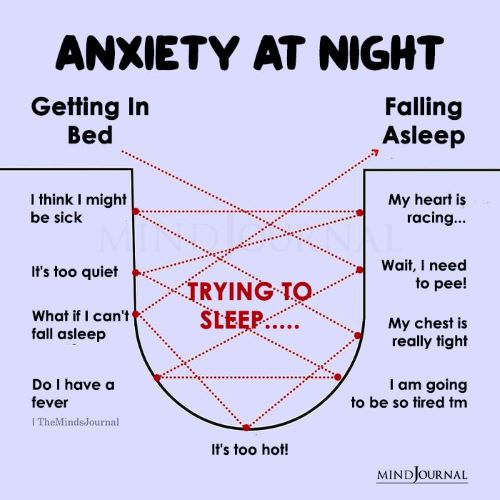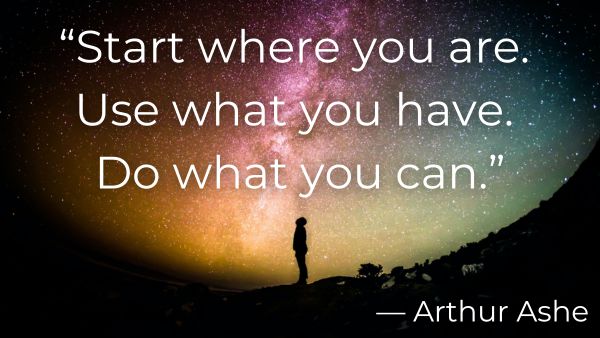As an anxiety therapist, my clients frequently share with me that they struggle to get a good night’s sleep due to their anxiety. The relentless thoughts and concerns as well as physical symptoms that accompany anxiety often make it challenging for them to fall and stay asleep.
In this article, we’ll explore six tips that I have seen help my client’s get a better night’s sleep. If you struggle with sleep due to your anxiety, I hope that they can help you, too!
Table of Contents

Journaling: A Mental Release
Journaling your thoughts can help you to address the mental symptoms of anxiety. Putting your concerns on paper gives your mind a chance to process them in a productive way that doesn’t get in the way of falling asleep (like worrying does!).
Take a few minutes a couple hours before bedtime to jot down your thoughts and concerns. Don’t worry about perfection as you’re writing; spelling and grammar aren’t important here. You can even use bullet points instead of complete sentences.
If you find it helpful, you can also brainstorm potential solutions to your concerns as you go. Or acknowledge and accept what is beyond your control. Keep this activity separate from your bed, fostering a clear mental distinction between the time to reflect and the time to rest.
If you notice that you get stuck on particular worries as you try to fall asleep, keep a notepad by your bedside. Write down whatever your concern is and give yourself permission to address the issue with a fresh perspective tomorrow when you are rested.
Creating a Cozy Haven: Set the Stage for Sleep
Transform your bedroom into a cozy haven by cleaning off your bed and ensuring the lighting is dim or dark. Adjust the temperature to a comfortable level, avoiding extremes of hot or cold.
Make your bed as comfortable as possible with blankets and pillows that are soft and aren’t too hot or not warm enough for the season.
By creating a tranquil environment, you signal to your mind that it’s time to unwind and prepare for a peaceful night’s sleep.

Winding Down with a Routine: Building a Bridge to Rest
Establish a pre-bedtime routine to give your mind a buffer between the stress of the day and the upcoming period of rest.
Your Wind Down Routine might include drinking a cup of herbal tea, putting on your favorite pajamas, washing your face, taking a bath, brushing your teeth, reading, or a combination of these or other activities.
Whatever your routine includes, try to give yourself at least 30 minutes to wind down and prepare yourself for bed. A consistent sequence of events signals to your mind to get ready for sleep.
Progressive Muscle Relaxation: Letting Go of Tension
Progressive Muscle Relaxation (PMR) can help you to address the physical symptoms of anxiety and release the physical tension accumulated throughout the day.
PMR addresses the tension built up in each muscle group and helps you to gradually relax your muscles. This exercise can be done at any time of day, but it can be particularly helpful if practiced in bed as you prepare to fall asleep. Don’t be surprised if you don’t make it to the end!
Alternatively, body scans are another mindfulness exercise that can promote relaxation and restful sleep if PMR isn’t for you.

Meditation Apps: Guiding Your Mind to Sleep
Meditation apps offer numerous tools that can be helpful for getting a better night’s sleep.
You can find sleep stories, meditations for sleep, and calming music tracks on platforms like Calm, Headspace, Insight Timer, Nothing Much Happens, YouTube, and others. If you’re interested, you can check out my article reviewing 14 of the most popular meditation apps.
Rather than going down an anxiety rabbit hole in your mind, these types of audios can give you something positive and calming to focus on as you fall asleep.
Be Intentional with Your Thoughts: Cultivating Calm
If you prefer not to listen to anything as you fall asleep, consciously choose a positive or neutral topic to focus on.
You can pick a word or mantra to repeat slowly in your mind, such as “sleepy” or “time to rest,” drawing out each syllable.
Alternatively, you can mentally go through your plan for the next day step-by-step (as long as this is not stressful). The more details you can include, the more boring this will be (and therefore more sleep inducing!).
You can also replay the events of an entertaining show or book. Or try to predict what might happen next in these stories. The goal is to keep your mind on whatever topic you find calming, rather than anxiety-inducing.
Final Thoughts on What to Do When Anxiety Gets in the Way of Sleep
Creating a serene bedtime routine and environment can significantly impact your ability to achieve better sleep, despite anxiety. By incorporating these tips into your nightly routine, you can cultivate tranquility, setting the stage for a night of more restful sleep.
Remember that the more you practice each of these tips, along with other good sleep hygiene practices, the better your sleep will be. Sweet dreams!

As a reminder, this blog post is not intended as professional counseling or clinical advice. This article is meant to provide you with some helpful information about improving your sleep when you struggle with anxiety. If you are struggling with your mental health, I encourage you to consider reaching out for additional support, professional or otherwise.

– Kristel Roper, LMFT, LPCC
Kristel Roper is a licensed psychotherapist offering therapy services to individuals in the Sacramento area. She specializes in therapy for anxiety and OCD and especially enjoys working with young women as they navigate the challenges of relationships, college, career, and beyond. If you have a question for Kristel or are interested in therapy for yourself or your loved one, feel free to reach out.
Photo by Simone Dalmeri on Unsplash
Photo by Kaique Rocha from Pexels
Photo by Greg Rakozy on Unsplash
